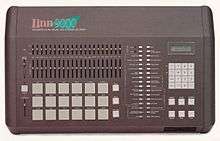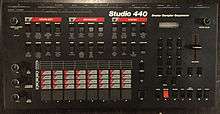Akai MPC60
|
Akai MPC60 | |
| Classification | Electronic sampler |
|---|---|
| Inventor(s) |
Akai Roger Linn |
The Akai MPC60 ("MIDI Production Center 60") is an electronic musical instrument produced in 1988, by the Japanese company Akai in collaboration with designer Roger Linn.[1]
It combined MIDI sequencing and audio sampling with a set of velocity/aftertouch-sensitive performance pads, to produce an instrument optimized for use as a drum machine. The MPC60 enjoyed great popularity, particularly among musicians producing hip hop and similar styles.
Precursors
The MPC60's success and popularity can perhaps be best understood in the context of earlier drum machines.
Early machines in the 1970s tended to use analogue synthesis for their sounds (characterful, but not very realistic) and only provided pre-set rhythms. By the late 1970s, use of microprocessors and affordable RAM memory led to the development of machines which allowed musicians to program their own rhythm patterns (e.g. the Roland CR-78).

In 1979, Roger Linn produced the world's first drum machine to use digital audio samples as the sound source, the Linn LM-1. This was very popular as these sampled sounds were generally much more realistic and "punchy" than analogue ones. Another innovation of the LM-1 was its operating system optimized for real-time recording and playback of drumbeats, introducing useful features such as automatic timing correction (quantization) and variable degrees of swing timing.
In 1983, the MIDI protocol was launched, as a standard way to interconnect electronic musical instruments, and quickly became very popular, replacing the plethora of manufacturer's incompatible proprietary interfaces. MIDI provided a ready way to synchronize the operation of drum machines with other studio devices, and enabled programmed rhythms to be exchanged as MIDI note data.


By the mid-1980s, machines such as the Sequential Circuits Inc. Studio 440 and Linn's own Linn 9000, combined powerful MIDI sequencers with the ability to sample one's own sounds. This offered much more flexibility in terms of what had been available before, both in terms of drum sounds, and the ability to integrate the drum machine with other studio devices. However neither of these machines were a great commercial success, and both Linn and Sequential ceased trading.
Roger Linn then began a design collaboration with Akai, drawing heavily on the Linn 9000 and Studio 440 concepts, resulting in the MPC60. Drummer Willie Wilcox produced & recorded many of the original drum sounds shipped with the original Akai MPC 60.
Features
- 16 velocity sensitive pads
- 4 pad banks (64 voices per program)
- sampling rate of 40 kHz (freq response 20 Hz - 18 kHz)
- 16-bit ADC and DAC, with data stored in special non-linear 12bit format (for lower noise)
- 750kB sampling memory (13.1 seconds), upgradable to 1.5MB (26.2 seconds) (expansion card: EXM003)
- 128 sounds in memory, 64 sounds per program, 16 voice polyphony.
- 2 MIDI inputs, 4 MIDI outputs
- 20 songs, 99 sequences, 99 tracks, 60,000 note capacity
- timing resolution of 96ppq (parts per quarter note)
- syncable via MIDI Time Code (MTC), MIDI Clock, FSK24, SMPTE, 1/4 note click.
- SMPTE supported frame rates: 24, 25, 29.97 drop, and 30.
- 8 assignable outputs + 1 stereo + 1 effects send/return
- Internal 3½" floppy drive (Double Density 720 kB)
- optional 3rd-party SCSI interface (by Marion Systems)
ASQ-10
In 1988, Akai also released the sequencer section of the MPC60 as a standalone hardware product in its own right, the ASQ10. As with the MPC60, this was renowned for its solid MIDI timing compared to computer software based systems.
MPC60II
In 1991, Akai re-launched the machine as the MPC60II. This incarnation nearly identical to the original MPC60, merely featuring a headphone output, and a plastic chassis instead of a metal one.
MPC 60 Sound Library
The MPC60 was widely supported by third-party sample sellers (and, of course, the instrument allowed users to do their own sampling). Many of the original MPC60 factory sounds were produced & recorded by drummer Willie Wilcox.
Details of Akai's own library are given below:
The original MPC60 came with four factory floppy disks, each with a different kit of sounds:
- Studio set
- Rock set
- Dry set
- Synth set
The Akai MPC60/MPC60II library consisted of the following:
- SL601 Samba set
- SL602 Ambience set
- SL603 New60's set
- SL604 Loft-drum
- SL605 Real-drum
- SL606 Solid-drum
- SL607 Native-drum
- SL608 Live-drum
- SL609 LA-1 set
- SL610 UK-1 set
- SL611 Percuss-1
- SL612 Power-drum
- SL613 Metal-drum
- SL614 UK-2 set
- SL615 UK-3 set
- SL616 UK-4 set
- SL617 UK-5 set
- SL618 UK-6 set
- SL619 UK-7 set
- SL620 UK-8 set
- SL621 Mix-1 Dry
- SL622 Mix-2 Gate
- SL623 Mix-3 Dry
- SL624 Rickyset 1
- SL625 Rickyset 2
- SL626 Rickyset 3
- SL627 Natural & Voxset
- SL628 Dance & Voxset
- SL629 New Funk
- SL630 Brushes
Further MPC60 operating system development by Roger Linn
In 2006, Roger Linn's company Roger Linn Design continues to support the MPC60. Upgrades available include:
- Operating system 3.10. This is basically the MPC3000 operating system, back-ported onto the MPC60 hardware.
- SCSI interface to allow connection to SCSI hard drives and tape drives for increased storage capacity over the original floppy disks.
See also
References
- ↑ "MPC60 Software". Rogerlinndesign.com.
